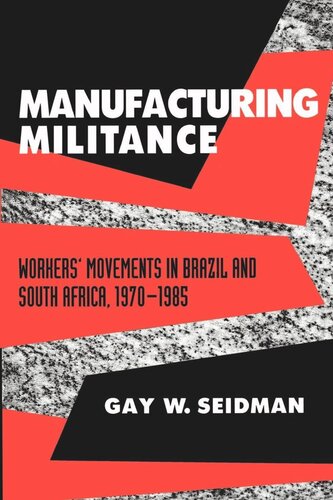

Most ebook files are in PDF format, so you can easily read them using various software such as Foxit Reader or directly on the Google Chrome browser.
Some ebook files are released by publishers in other formats such as .awz, .mobi, .epub, .fb2, etc. You may need to install specific software to read these formats on mobile/PC, such as Calibre.
Please read the tutorial at this link. https://ebooknice.com/page/post?id=faq
We offer FREE conversion to the popular formats you request; however, this may take some time. Therefore, right after payment, please email us, and we will try to provide the service as quickly as possible.
For some exceptional file formats or broken links (if any), please refrain from opening any disputes. Instead, email us first, and we will try to assist within a maximum of 6 hours.
EbookNice Team

Status:
Available0.0
0 reviews
ISBN 10: 0520913973
ISBN 13: 9780520913974
Author: Gay W Seidman
Challenging prevailing theories of development and labor, Gay Seidman's controversial study explores how highly politicized labor movements could arise simultaneously in Brazil and South Africa, two starkly different societies. Beginning with the 1960s, Seidman shows how both authoritarian states promoted specific rapid-industrialization strategies, in the process reshaping the working class and altering relationships between business and the state. When economic growth slowed in the 1970s, workers in these countries challenged social and political repression; by the mid-1980s, they had become major voices in the transition from authoritarian rule.
Based in factories and working-class communities, these movements enjoyed broad support as they fought for improved social services, land reform, expanding electoral participation, and racial integration.
In Brazil, Seidman takes us from the shopfloor, where disenfranchized workers organized for better wages and working conditions, to the strikes and protests that spread to local communities. Similar demands for radical change emerged in South Africa, where community groups in black townships joined organized labor in a challenge to minority rule that linked class consciousness to racial oppression. Seidman details the complex dynamics of these militant movements and develops a broad analysis of how newly industrializing countries shape the opportunities for labor to express demands. Her work will be welcomed by those interested in labor studies, social theory, and the politics of newly industrializing regions.
CHAPTER ONE Militant Labor Movements in Brazil and South Africa
HISTORICAL DIFFERENCES
PATTERNS OF MOBILIZATION
A COMPARATIVE PUZZLE
CHAPTER TWO Conditions for Industrial Growth, 1960-1973
BRAZILIAN INDUSTRIALIZATION STRATEGIES
INDUSTRIALIZATION IN SOUTH AFRICA
CONCLUSION
CHAPTER THREE Business Opposition and Its Limits
BRAZIL: COLLAPSE OF AN ALLIANCE?
BUSINESS OPPOSITION IN SOUTH AFRICA
CONCLUSION
CHAPTER FOUR The Emergence of “New Unionism”
BRAZIL: “MÁQUINAS PARADAS E BRAÇOS CRUZADOS”
SOUTH AFRICA: “THE SPIRIT LIVES”
LABOR MILITANCE IN BRAZIL AND SOUTH AFRICA
CHAPTER FIVE Community Struggles and the Redefinition of Citizenship
BRAZIL: “O POVO EM MOVIMENTO”
SOUTH AFRICA: COMMUNITY, RACE, AND CLASS
CONCLUSION
Conclusion
EXPLAINING SIMILAR DYNAMICS
MILITANT WORKERS’ MOVEMENTS IN COMPARATIVE PERSPECTIVE
LABOR MOVEMENTS IN LATE INDUSTRIALIZERS
Notes
books on manufacturing engineering
war manufacturing
8 manufacturing wastes
7 ways manufacturing
7 manufacturing wastes
manufacturing text books
Tags: Gay W Seidman, Manufacturing, Militance